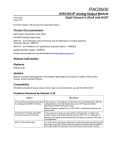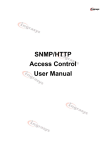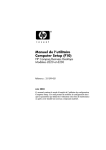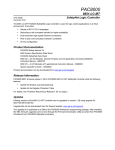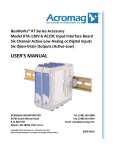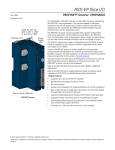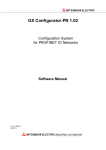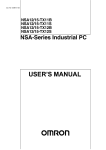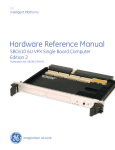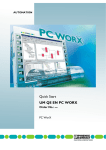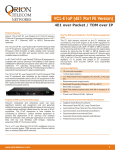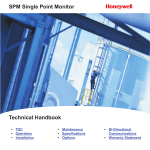Download PAC8000 PROFINET Scanner Module
Transcript
PAC8000 8515-BI-PN, 8516-BI-PN and 8752-CA-NS GFK-2826 May 2013 PROFINET Scanner Modules The PAC8000 PROFINET Scanner (PNS) module interfaces PAC8000 IO modules to a PROFINET IO-Controller. The PNS scans the modules in its node, retrieving input data and providing output data, and publishes input data on the PROFINET Network at the configured update rate. The PNS manages PROFINET communication and module configuration between an IO-Controller and IO modules attached to PNS. If network communications are lost, the PNS manages I/O states according to the individual IO module configurations. The PNS is available in two variants to allow you to use the network media that meet the requirements of your application. 8515-BI-PN: Two 10/100 Mbps copper interfaces 8516-BI-PN: Two 100Mbps Multi-Mode fiber (MMF) ports Above PNS modules require the following carrier to connect with 8000 IOs. 8752-CA-NS: PAC8000 Node Service Carrier The PNS will provide all the functions, services and protocols required for certification as per PROFINET IO version 2.2. 8515-BI-PN/8516-BI-PN: PAC8000 PROFINET Scanner Module Features Standard PROFINET alarm and diagnostics reporting. Supports configuration using Classless Inter Domain Routing (CIDR) with sub-netting and super-netting. Each PNS can be connected into a daisy-chain/line, star, or ring (redundant media) topology. Supports Media Redundancy Protocol (MRP) client mode operation. Supports Heart beat: Informs PROFINET Controller that PNS is active and functioning. Can be upgraded in the field; supports firmware updates via USB port. Note: The USB port is for firmware upgrades only. It is not intended for permanent connection. Compliant with EU RoHS directive using the following exemptions identified in the Annex: 7C-I &7C-III PROFINET Scanner Modules 2 GFK-2826 The PNS module’s functions include: Scanning all directly connected input modules and writing to all directly connected output modules Publishing data onto the PROFINET IO-Controller at a customer-specified update rate. Receive data from a PROFINET IO-Controller at a customer-specified update rate. Managing PROFINET communication and IO module configuration between an IO-Controller and IO modules of PNS node. Managing the state of the I/O when communications is lost Publishing fault information (alarms, diagnostics, etc.) to IO-Controller Specifications PROFINET Support PROFINET Version 2.2 Class A IO-Device RX3i PLC CPU Version Required Firmware version 7.0 or later Proficy Machine Edition Version Version 7.5 SIM 3 or later V2.2 GSDML and Proficy Machine Edition/3rd-Party tools. Required Power Requirements 8515-BI-PN 4.5 Watts (5.5 Watts Max) 8516-BI-PN 6.0 Watts (7.2 Watts Max) Module Dimensions 128.3mm X 160.3mm X 47.78mm (5.05" X 6.31" X 1.88") Module weight 150g Carrier Required 8752-CA-NS : PAC8000 Node Services Carrier Operating Temperature Range 8515-BI-PN -40˚C to +70˚C 8516-BI-PN -40˚C to +70˚C Horizontal DIN rail mounting. Optimum orientation is when the carrier is mounted in a vertical plane with field terminals for communication cables located below the modules. Number of Port Connectors 8515-BI-PN : Two RJ-45 8516-BI-PN : Two SC-Duplex USB Connector (for firmware upgrades) One Micro-B connector. USB 2.0 compliant running at Full-speed (12 MHz) PNS Status and Control Bits 64 input status bits and 16 output control bits I/O Data Update on the PROFINET LAN Configurable: 1ms, 2ms, 4ms, 8ms, 16ms, 32ms, 64ms, 128ms, 256ms and 512ms (Recommended is 4 ms and above) Number of IP addresses One. Supports Classless Inter-Domain Routing (CIDR) Number of MAC Addresses Three. One per external port and one internal. External MAC addresses are only used for specialized Ethernet protocols such as MRP or LLDP I/O Station Maximum Limits Number of I/O Modules per Node 32 I/O data per station 2880 bytes total 1440 bytes of input data 1440 bytes of output data RoHS Compliance Yes Configuration Configured using Proficy Machine Edition when used with a PACSystems RX3i PROFINET Controller (PNC) module, as part of an RX3i PROFINET network. rd V2.3 GSDML file is available for import into 3 -Party tools. IO Carrier 8709-CA-08 For PNS installation, configuration and operating information, refer to the PAC8000* IO PROFINET Scanner User’s Manual, GFK-2839 PROFINET Scanner Modules 3 GFK-2826 LEDs The PNS has eleven LEDs that indicate the presence of power and show the operating mode and status of the PNS. Name Color Description POWER Green ON = Power OK OFF = No power OK Green ON = PNS is OK and completed system boot up successfully BLINK pattern = See table below for description MASTER Yellow Not used in current release CONNECT Yellow ON = One or more PROFINET application relationships (ARs) has been established OFF = No PROFINET application relationships (ARs) are established SLOW BLINK = The PROFINET Scanner has not been assigned a name. FAULT Red ON = One of the configured IO module or PNS itself is in fault state SLOW BLINK = Invalid MAC addresses OFF = All configured IO modules are in healthy state LAN Yellow IRREGULAR BLINK = Node is processing the packets addressed to it OFF = No activity PORT 1 Yellow ON = Link connected OFF = Link failure IRREGULAR BLINK = Activity on this port. PORT 2 Yellow ON = Link connected OFF = Link failure IRREGULAR BLINK = Activity on this port. USB Yellow ON = USB connection is active, but no data is being transferred OFF = No activity on USB IRREGULAR BLINK = Activity on USB I/O COMM Yellow ON = All IO module commands were successful in last two seconds OFF = No IO module command was sent in last two seconds IRREGULAR BLINK = At least one IO Module command failed in last two seconds A-B LINK Yellow Not used in current release PROFINET Scanner Modules 4 GFK-2826 LED Blink Patterns Multiple LEDs can blink in patterns that indicate special conditions: Pattern Displayed Description CONNECT, FAULT, LAN, PORT 1, PORT 2 LED's go ON in order, from bottom to top. After the top LED (CONNECT) has been ON for about 45 ms, the LEDs go Off from top to bottom, until all of the LEDs are Off. After all of the LEDs have been Off for about 45 ms, the pattern is repeated. Module Identification Requested (Initiated by PME or any DCP client and is used to locate and/or identify a PROFINET Scanner) CONNECT, FAULT, LAN, PORT 1, PORT 2 LED's blink slow (ON for 0.5 seconds, OFF for 0.5 seconds) in unison. Firmware Update Mode (Application/FPGA) MASTER, CONNECT, FAULT, LAN, PORT 1, PORT 2 LED's blink slow (ON for 0.5 seconds, OFF for 0.5 seconds) in unison. Firmware Update Mode (Boot loader) OK, CONNECT ,FAULT, LAN, PORT 1, PORT 2 The CONNECT, FAULT, LAN, PORT 1 and PORT 2 LEDs flash once. The OK LED blinks an (2-digit hexadecimal) error code. The pattern is repeated until the module is reset or power-cycled. PROFINET Scanner Modules 5 GFK-2826 8752-CA-NS PAC8000 Node Service Carrier Features Accommodates two +12V Power Supplies Provides support for 12V (PNS power), 24V (Bussed Field Power) power fail monitoring Same size of 4-way IO carrier Can be used with DIN rail or panel mounting Carrier Specifications Hazardous Area Approvals Location of Node Zone 2, IIC T4 hazardous area Electrical Railbus connector Male out Ground Connection M4 screw terminal (x1) BFP0V Connection M4 screw terminal (x1) System Power Connections 6-pin (Male) Note: This does not provide power to the PNS module Bussed Field Power (BFP) Fail Connector 12-pin (Male) Environmental Requirements Ambient temperature: Operating Storage -40°C to 70°C -40°C to 85°C Relative humidity 5 to 95% (non-condensing) Vibration and shock See PAC8000 System Specification Data Sheet Materials Carrier molding Modified poly-phenylene oxide Printed wiring board Epoxy resin woven glass laminate (TBD) Mechanical Dimensions (overall) Weight (approximate) 178 (w) x 170 (d) x 68 (h) mm 450g Mounting Flat panel (two fasteners) or DIN rail DIN rail types “Top hat,” 7.5 x 35 mm to EN 50022 .or 15 x 35 mm to EN 50022 or G-section, to EN 50035 PROFINET Scanner Modules 6 GFK-2826 Carrier Diagram Ordering Information 8515-BI-PN PAC8000 PROFINET Scanner Module, Two 10/100Mbps copper interface 8516-BI-PN PAC8000 PROFINET Scanner Module, Two 100Mbps Multi-Mode fiber (MMF) ports 8752-CA-NS PAC8000 Node Service Carrier Supported IO Modules 8103-AI-TX 8 Channel Analog Input Module, single-ended 4-20 mA input channels 8104-AO-IP 8 Channel Analog Output Module, 4–20 mA single-ended outputs 8109-DI-DC 8 Channel Digital Input Module, 24 V DC, isolated, sinking. 8115-DO-DC 8 Channel Digital Output Module, 2-60 V DC, non-isolated, module powered 8110-DI-DC 8-channel Digital Input, 24 V dc, non-isolated, module powered 8111-DI-AC 8-channel Digital Input, 115 V ac, isolated, sinking 8112-DI-AC 8-channel Digital Input, 115 V ac, non-isolated, module powered 8113-DI-AC 8-channel Digital Input 230 V ac, isolated, sinking 8114-DI-AC 8-channel Digital Input, 230 V ac, non-isolated, module powered 8116-DO-AC 8-channel Digital Output, 20–265 V ac, non-isolated, module powered 8117-DO-DC 8-channel Digital Output, 2–60 V dc, isolated, unpowered 8118-DO-AC 8-channel Digital Output, 20–265 V ac, isolated, unpowered 8119-VI-05 8-channel Analog Input, 1–5 V Installation in Hazardous Areas PROFINET Scanner Modules 7 GFK-2826 The following information is for products bearing the UL marking for Hazardous Locations or ATEX marking for explosive atmospheres: EQUIPMENT LABELED WITH REFERENCE TO CLASS I, DIVISION 2, GROUPS A, B, C & D, HAZARDOUS LOCATIONS (ALTERNATIVELY MARKED AS CLASS I ZONE 2, GROUP IIC) IS SUITABLE FOR USE IN CLASS I, DIVISION 2, GROUPS A, B, C, D OR NON-HAZARDOUS LOCATIONS ONLY Equipment labeled with Connectors P1, J101 & HVCC shall be secured properly with the mechanical latch provided for the purpose. WARNING - EXPLOSION HAZARD - SUBSTITUTION OF COMPONENTS MAY IMPAIR SUITABILITY FOR CLASS I, DIVISION 2; WARNING - EXPLOSION HAZARD - WHEN IN HAZARDOUS LOCATIONS, TURN OFF POWER BEFORE REPLACING OR WIRING MODULES; AND WARNING - EXPLOSION HAZARD - DO NOT DISCONNECT EQUIPMENT UNLESS POWER HAS BEEN SWITCHED OFF OR THE AREA IS KNOWN TO BE NONHAZARDOUS. WARNING - EXPLOSION HAZARD - USB PORT IS ONLY FOR USE IN NONHAZARDOUS LOCATIONS, DO NOT USE UNLESS AREA IS KNOWN TO BE NON-HAZARDOUS. II 3 G is suitable for use in Group 2 Category 3 environments. ATEX Marking II 3 G Ex nA IIC T5 -40ºC Ta +70ºC (Ref. ATEX Cat-3 certificate# GE13ATEX8515X & GE13ATEX8516X from our support website for details of marking and installation guidelines.) CE Marking CE (EMC & ATEX Directives) (Ref. Declaration of Conformity from our support website for details) UL Marking cULus LISTED FOR US and CANADA FOR HAZLOC & PROCESS CONTROL INSTRUMENTS CATEGORY HAZLOC Classification Class I Zone 2 Group IIC Class I Division 2 Groups A, B, C, D PROFINET Scanner Modules 8 GFK-2826 Quick Start Installation and initial startup procedures for the PNS include the following steps. Before installing and operating the PNS, refer to the PAC8000 PROFINET Scanner Manual, GFK-2839 1. Pre Installation Check: Upon receiving your PAC8000 PNS equipment, carefully inspect all shipping containers for damage. If any part of the system is damaged, notify the carrier immediately. The damaged shipping container should be saved as evidence for inspection by the carrier. As the consignee, it is your responsibility to register a claim with the carrier for damage incurred during shipment. However, GE Intelligent Platforms will fully cooperate with you, should such action be necessary. After unpacking the PAC8000 PNS equipment, record all serial numbers. Serial numbers are required if you should need to contact Customer Care during the warranty period. All shipping containers and all packing material should be saved should it be necessary to transport or ship any part of the system. 2. Installing PNS module on Carrier FIT THE CARRIER ON DIN RAIL LOCK THE CARRIER IN PLACE WITH 4 SCREWS MARKED THRU THE HOLE ON MODULE GUIDE THE MODULE ONTO THE CONNECTORS AND LOCK WITH 2 PLASTIC SCREWS SHOWN 3. Connecting the PNS to the PROFINET network and to a 10BaseT, 100BaseTX or 1000BaseT IEEE 802.3 network for general Ethernet communications Each port on a PAC8000 PNS operates independently (the ports are connected via an internal switch), so devices that operate at different speeds and/or duplex modes may be attached to the ports. Each port automatically detects the attached cable and functions properly with either straight-through or crossover cables. Note: The PAC8000 PROFINET Scanner operates only in auto-negotiate mode. All PROFINET network devices and switches that are connected to the PAC8000 PROFINET Scanner should be configured to use auto-negotiation. 4. Installing the USB port driver (optional) The PNS provides a micro USB port for connection to a computer running Windows 2000, Windows XP, Windows Vista, or Windows 7 operating system. The USB port is only used for firmware updates. USB driver files are provided as part of upgrade packages compatible with the PROFINET Scanner. The PNS includes a driver-install application that can be used to enable a computer to communicate with a PNS via its USB port. PROFINET Scanner Modules 9 GFK-2826 5. Installing SFP devices: Warning Optical SFPs use an invisible laser to generate a fiber-optic signal. Always keep the port covered if a cable is not installed. Do not look into the open port if a cable is not installed. Warning If the surrounding air operating temperature of the PNS is greater than 40 °C (104 °F), SFP devices could have operating temperatures over 70 °C (158 °F). Under these conditions, for your safety, do not use bare hands to remove an SFP device from the SFP cage. Use protective gloves or a tool (needle-nose pliers) to avoid handling the hot SFP device directly when removing the SFP device. 6. Assigning an IO Device Name to the PNS Before attempting to connect to or configure the PAC8000 PNS, the IO Device Name must be set with a Discovery and Configuration Protocol (DCP) tool, such as the Proficy Machine Edition Discovery Tool. 7. Configuring the PNS and its IO Modules on a PROFINET network Proficy Machine Edition (or any 3rd party tool required by your IO Controller) is used to configure a PAC8000 PROFINET network. The configuration must match actual hardware present exactly or attempted PROFINET connections will result in a Loss of Device fault. The GSDML file, GSDML-V2.2-GEIP-PAC8000PNS-20130122.xml, for the PAC8000 PNS must be imported into Proficy Machine Edition (or 3rd part tool) in order to configure the PAC8000 PNS. Supported Network Media Types and Distances Media Type 100BASE-FX 10/100BASE-T Connector Type Wavelength (nm) SC or SC-Duplex 1300 RJ45 Media Type MMF - CAT5/CAT5e/CAT6 Modal Bandwidth (MHz – Km) Core Size (μm) 62.5 500 50 400 50 500 - - Maximum Distance (m) 2 – 2,000 (FullDuplex) 2 – 400 (HalfDuplex) 100 (maximum) PROFINET IO over wired infrastructure must be 100Mbps full-duplex or faster. The hardware is capable of operating at 10Mbps but should not be used for PROFINET unless it is PROFINET over wireless (802.11). External Power Supply Connections Terminal Function 1 PF1: Power Fail Signal From PSU 1 2 0V Input (PSU 1) 3 +12V Input (PSU 1) 4 +12V input (PSU 2) 5 0V Input (PSU 2) 6 PF2: Power Fail Signal From PSU 2 PROFINET Scanner Modules 10 GFK-2826 BFP Monitor Connections Terminal Function 1 24VA: 24V from BFP PSU 1/2 2 24VB: 24V from BFP PSU 3/4 3 BFP0V 4 PF3: AUX signal from BFP PSU 1 5 BFP0V 6 PF4: AUX signal from BFP PSU 2 7 BFP0V 8 PF5: AUX signal from BFP PSU 3 9 BFP0V 10 PF6: AUX signal from BFP PSU 4 11 TERM1: (Reserved) 12 TERM2: (Reserved) PROFINET Scanner Modules 11 GFK-2826 Important Product Information for this Release Release History Version 8515-BI-PN 8516-BI-PN Firmware Release 1.00 Date March 2013 Comments Initial release Compatibility Subject Description Proficy Machine Edition Requirements Proficy Machine Edition version 7.50 Build 5517P, SIM-3 and above Upgrading From Previous Firmware Versions N/A. Initial/First release. Downgrade To Previous Firmware Versions N/A. Initial/First release. Problems Resolved in This Release N/A (Initial release) New Features and Enhancements N/A (Initial release) Restrictions and Open Issues Subject Description PROFINET stack does not support IOCS (Input/Output Consumer Status). The PROFINET stack used for this release does not support Input/Output Consumer Status at the application level. This means the PNS cannot inform the PNC whether the data sent to PNS is correctly consumed at the I/O module. In the opposite direction, the PNS is also not able to know whether the data sent from PNS is correctly consumed at the CPU. The primary impact of this is that the PNS does not set point faults in the CPU for operational faults PNS rejects setting its subnet mask & gateway to 0.0.0.0 The PNS does not support a subnet mask of 0.0.0.0. When a hardware configuration with LAN subnet mask address set to 0.0.0.0 is downloaded to the RX3i system, the PNS will fail to connect to the PNC. PNS does not generate an alarm when MRP domain name is mismatched When the PNS is configured as a Client to a third-party Media Redundancy Manager and the domain names do not match, the PNS does not report an alarm. User should be careful while setting the domain name and should not assign different domain names to IO controller and PAC8000 PNS associated with it. Neglecting this leads to failure in reporting alarms. PROFINET Scanner Modules 12 GFK-2826 Operational Notes Subject Description Ethernet port operation The PROFINET Scanner requires at least one network to be operating at full duplex for a connection to remain established. The PROFINET protocol may be sent and received over either or both of the two external ports. Devices connected to the PROFINET Scanner ports should have Ethernet Autonegotiation enabled unless the IO-Controller supports configuring the port operation mode. If the IO-Controller configures the PROFINET Scanner port to a specific setting with autonegotiation disabled, the device connected to the PROFINET Scanner must be configured for exactly the same setting. USB port drivers When connecting the USB cable to the PROFINET Scanner, you may receive a warning for installing a driver that has not passed Windows Logo testing. Each PROFINET Scanner is recognized as a separate Windows device with separate installation as each has a unique serial number. This is normal operation for this release. Network parameters for IO-Devices If the network parameters (IP Address, subnet mask, and gateway IP) assigned by the DCP tool are different from the configuration in the IOController and the IO-Controller is configured to assign IP settings to devices, when the IO Controller assigns its IP settings, the settings previously stored from the DCP tool are lost. On a reset, the IO-Device is set to factory default values (0.0.0.0/0.0.0.0/0.0.0.0) as prescribed by the PROFINET specification. On configuration download, only one configuration error per module is reported even though it has multiple errors. On configuration download, when PNS detects first configuration fault, it reports the fault and continues verifying configuration faults of next IO module. It will not report the second fault of that module until the first configuration fault is addressed. This saves flooding system with configuration faults. Configuration mismatch logged twice when downloaded configuration does not match with the physical module on setup. When configuration is downloaded to PNS first time after power-up, if downloaded configuration does not match with physical IO module, PNS reports “system configuration mismatch” fault and also resets the corresponding IO module to bring it to default state. Reset of IO module causes logging of additional fault “loss of IO module” and re-reporting of “system configuration mismatch”.












